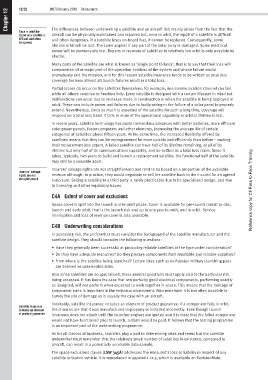Page 352 - M97TB9_2018-19_[low-res]_F2F_Neat2
P. 352
12 12/22 M97/February 2018 Reinsurance
Chapter
Once in orbit the The differences between underwriting a satellite and an aircraft risk mainly arises from the fact that the
repair of a satellite is aircraft can be physically maintained and repaired but, once in orbit, the repair of a satellite is difficult
difficult and often and often dangerous. If a satellite loses on-board fuel, it cannot be replaced. Consequently, some
dangerous
lifetime orbit will be lost. The same applies if any part of the solar array is damaged. Some electrical
power will be permanently lost. Repairs or recovery of satellites in relatively low orbit is only possible by
shuttle.
Many parts of the satellite are what is known as ‘single point failures’, that is to say that their loss will
compromise all or major part of the operation sections of the system and whose failure would
prematurely end the mission, and for this reason satellite insurance tends to be written as total loss
coverage because almost all launch failures result in a total loss.
Partial losses do occur on the satellites themselves; for example, one communication channel can fail
while all others continue to function fully. Every satellite is designed with a certain lifespan in mind but
malfunctions can occur due to mistakes made in construction or when the satellite is being deployed in
orbit. These can include power unit failures due to faulty wiring or the failure of a solar panel to properly
extend. Nevertheless, since so much is expected of the satellite for such a long time, coverage will
respond on a total loss basis if 50% or more of the operational capability or orbital lifetime is lost.
In recent years, satellite technology has made tremendous advances with better batteries, more efficient
solar power panels, faster computers and other elements, increasing the average life of certain
categories of satellites above fifteen years. At the same time, the increased flexibility offered by
satellites means that they can be reprogrammed far more quickly and efficiently than before – making
their replacement less urgent. A failed satellite can have half of its lifetime remaining, or all of its
lifetime but only half of its communications capability, and be settled as a total loss claim. Since it
takes, typically, two years to build and launch a replacement satellite, the functional half of the satellite
may still be a valuable asset.
Insurers’ salvage rights are not straightforward and tend to be based on a proportion of the available
Insurers’ salvage
rights are not revenue although, in practice, they would negotiate to sell the satellite back to the insured for an agreed
straightforward lump sum. Selling a satellite to a third party is rarely practicable due to its specialised design, and due
to licensing and other regulatory issues. Reference copy for CII Face to Face Training
C4A Extent of cover and exclusions
Space cover is split into the launch and in-orbit phase. Cover is available for pre-launch transit to site,
launch and early orbit, that is the launch risk and up to one year in orbit, and in-orbit. Service
interruption and loss of revenue cover is also available.
C4B Underwriting considerations
In assessing risk, the underwriter must consider the background of the satellite manufacturer and the
satellite design. They should consider the following questions:
• Have they generally been successful at producing reliable satellites of the type under consideration?
• Do they have adequate resources? Do they procure components from reputable and reliable suppliers?
• From where is the satellite being launched? Certain sites such as ex-Russian military launching pads
are deemed as uninsurable sites.
Also since satellites are so specialised, these general questions must apply also to the particular risk
being assessed. It has been the case that two perfectly good electrical components, performing exactly
as designed, will not perform when expected to work together in space. This means that the heritage of
component parts is important in the technical assessment. Also remember it is not often possible to
survey the site of damage as is usually the case with an aircraft.
Inevitably, satellite insurance includes an element of product guarantee. If a component fails in orbit,
Satellite insurance
includes an element the chances are that it was manufactured improperly or installed incorrectly. Even though launch
of product guarantee insurance does not attach until the launcher engines are ignited and it is clear that the failed component
would not have functioned prior to launch, a claim would be paid. It follows that the testing programme
is an important part of the underwriting programme.
As for all classes of business, statistics play a part in determining rates and terms but the satellite
underwriter must remember that the relatively small number of satellites in existence, compared to
aircraft, can result in a potentially unreliable data sample.
The space exclusions clause (LSW 345A) addresses the reinsured’s loss or liability in respect of any
satellite or launch vehicle. It is reproduced in appendix 12.5, which is available on RevisionMate.

